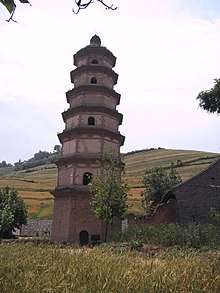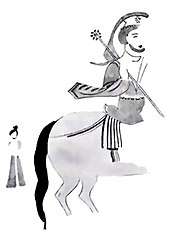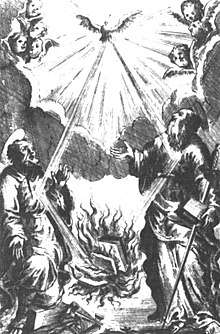Nestorianism
Nestorianism is a Christian theological doctrine that upholds several distinctive teachings in the fields of Christology and Mariology. It opposes the concept of hypostatic union and emphasizes that the two natures (human and divine) of Jesus Christ were joined by will rather than personhood. This Christological position is defined as radical dyophysitism.[1] Nestorianism was named after Christian theologian Nestorius (386–450), Patriarch of Constantinople from 428 to 431, who was influenced by Christological teachings of Theodore of Mopsuestia at the School of Antioch.
| Part of a series on |
| Christology |
|---|
Nestorius' teachings brought him into conflict with other prominent church leaders, most notably Cyril of Alexandria, who criticized especially his rejection of the title Theotokos ("Mother of God") for Mary, the mother of Jesus, and issued 12 anathemas against him at a council in Rome in 430. Nestorius and his teachings were eventually condemned as heretical at the Council of Ephesus in 431, and again at the Council of Chalcedon in 451, which led to the Nestorian Schism; churches supporting Nestorian teachings broke with the rest of the Christian Church.
Following that, many of Nestorius's supporters relocated to the Sasanian Empire, where they affiliated with the local Christian community, known as the Church of the East. However, some such as Sebastian Brock consider referring to the Assyrian Church of the East as the "Nestorian Church" to be "inappropriate and misleading."[2]
Christology
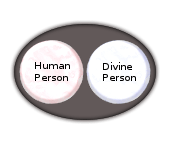
Nestorianism is a form of dyophysitism,[1] differing from orthodox dyophysitism on several points, mainly by opposition to the concept of hypostatic union. It can be seen as the antithesis to Eutchyan Monophysitism, which emerged in reaction to Nestorianism. Where Nestorianism holds that Christ had two loosely united natures, divine and human, Monophysitism holds that he had but a single nature, his human nature being absorbed into his divinity. A brief definition of Nestorian Christology can be given as: "Jesus Christ, who is not identical with the Son but personally united with the Son, who lives in him, is one hypostasis and one nature: human."[4] This contrasts with Nestorius' own teaching that the Word, which is eternal, and the Flesh, which is not, came together in a hypostatic union, 'Jesus Christ', Jesus thus being both fully man and God, of two ousia (Ancient Greek: οὐσία) but of one prosopon.[5] Both Nestorianism and Monophysitism were condemned as heretical at the Council of Chalcedon.
History
Nestorianism was condemned as heresy at the Council of Ephesus. The Armenian Church rejected the Council of Chalcedon (451) because they believed Chalcedonian Definition was too similar to Nestorianism. The Persian Nestorian Church, on the other hand, supported the spread of Nestorianism in Persarmenia. The Armenian Church and other eastern churches saw the rise of Nestorianism as a threat to the independence of their Church. Peter the Iberian, a Georgian prince, also strongly opposed the Chalcedonian Creed.[6] Thus, in 491, Catholicos Babken I of Armenia, along with the Albanian and Iberian bishops met in Vagharshapat and issued a condemnation of the Chalcedonian Definition.[7]
Nestorians held that the Council of Chalcedon proved the orthodoxy of their faith and had started persecuting non-Chalcedonian or Monophysite Syrian Christians during the reign of Peroz I. In response to pleas for assistance from the Syrian Church, Armenian prelates issued a letter addressed to Persian Christians reaffirming their condemnation of the Nestorianism as heresy.[6]
Following the exodus to Persia, scholars expanded on the teachings of Nestorius and his mentors, particularly after the relocation of the School of Edessa to the (then) Persian city of Nisibis (modern-day Nusaybin in Turkey) in 489, where it became known as the School of Nisibis. Nestorian monasteries propagating the teachings of the Nisibis school flourished in 6th century Persarmenia.[6]
Despite this initial Eastern expansion, the Nestorians' missionary success was eventually deterred. David J. Bosch observes, "By the end of the fourteenth century, however, the Nestorian and other churches—which at one time had dotted the landscape of all of Central and even parts of East Asia—were all but wiped out. Isolated pockets of Christianity survived only in India. The religious victors on the vast Central Asian mission field of the Nestorians were Islam and Buddhism".[8]
Nestorian doctrine
Nestorius developed his Christological views as an attempt to understand and explain rationally the incarnation of the divine Logos, the Second Person of the Holy Trinity as the man Jesus. He had studied at the School of Antioch where his mentor had been Theodore of Mopsuestia; Theodore and other Antioch theologians had long taught a literalist interpretation of the Bible and stressed the distinctiveness of the human and divine natures of Jesus. Nestorius took his Antiochene leanings with him when he was appointed Patriarch of Constantinople by Byzantine emperor Theodosius II in 428.
Nestorius's teachings became the root of controversy when he publicly challenged the long-used title Theotokos[9] ("God-Bearer") for Mary. He suggested that the title denied Christ's full humanity, arguing instead that Jesus had two persons (dyoprosopism), the divine Logos and the human Jesus. As a result of this prosopic duality, he proposed Christotokos (Bringer forth of Christ) as a more suitable title for Mary.
Nestorius' opponents found his teaching too close to the heresy of adoptionism – the idea that Christ had been born a man who had later been "adopted" as God's son. Nestorius was especially criticized by Cyril, Patriarch of Alexandria, who argued that Nestorius's teachings undermined the unity of Christ's divine and human natures at the Incarnation. Some of Nestorius's opponents argued that he put too much emphasis on the human nature of Christ, and others debated that the difference that Nestorius implied between the human nature and the divine nature created a fracture in the singularity of Christ, thus creating two Christ figures.[10] Nestorius himself always insisted that his views were orthodox, though they were deemed heretical at the Council of Ephesus in 431, leading to the Nestorian Schism, when churches supportive of Nestorius and the rest of the Christian Church separated. A more elaborate Nestorian theology developed from there, which came to see Christ as having two natures united, or hypostases,[11] the divine Logos and the human Christ. However, this formulation was never adopted by all churches termed "Nestorian". Indeed, the modern Assyrian Church of the East, which reveres Nestorius, does not fully subscribe to Nestorian doctrine, though it does not employ the title Theotokos.[12]
Nestorian Schism and early history

- (Not shown are non-Nicene, nontrinitarian, and some restorationist denominations.)
Nestorianism became a distinct sect following the Nestorian Schism, beginning in the 430s. Nestorius had come under fire from Western theologians, most notably Cyril of Alexandria. Cyril had both theological and political reasons for attacking Nestorius; on top of feeling that Nestorianism was an error against true belief, he also wanted to denigrate the head of a competing patriarchate. Cyril and Nestorius asked Pope Celestine I to weigh in on the matter. Celestine found that the title Theotokos[9] was orthodox, and authorized Cyril to ask Nestorius to recant. Cyril, however, used the opportunity to further attack Nestorius, who pleaded with Emperor Theodosius II to call a council so that all grievances could be aired.[12]
In 431 Theodosius called the Council of Ephesus. However, the council ultimately sided with Cyril, who held that the Christ contained two natures in one divine person (hypostasis, unity of subsistence), and that the Virgin Mary, conceiving and bearing this divine person, is truly called the Mother of God (Theotokos, meaning, God-bearer). The council accused Nestorius of heresy, and deposed him as patriarch.[13] Upon returning to his monastery in 436, he was banished to Upper Egypt. Nestorianism was officially anathematized, a ruling reiterated at the Council of Chalcedon in 451. However, a number of churches, particularly those associated with the School of Edessa, supported Nestorius – though not necessarily his doctrine – and broke with the churches of the West. Many of Nestorius' supporters relocated to the Sasanian Empire of Iran, home to a vibrant but persecuted Christian minority.[14] In Upper Egypt, Nestorius wrote his Book of Heraclides, responding to the two councils at Ephesus (431, 449).[15]
The Church of the East
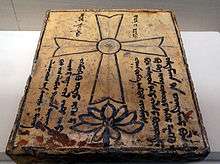
Persia had long been home to Christian communities that had been persecuted by the Zoroastrian majority, which had accused local Christians of pro-Roman leanings. In 424, the Church in Persia declared itself independent of the Byzantine Church and all other churches, in order to ward off allegations of foreign allegiance. Following the Nestorian Schism, the Persian Church increasingly aligned itself with the Nestorians, a measure encouraged by the Zoroastrian ruling class. The Persian Church became increasingly Nestorian in doctrine over the next decades, furthering the divide between Chalcedonian Christianity and the Nestorians. In 486 the Metropolitan of Nisibis, Barsauma, publicly accepted Nestorius' mentor, Theodore of Mopsuestia, as a spiritual authority. In 489 when the School of Edessa in Mesopotamia was closed by Byzantine Emperor Zeno for its Nestorian teachings, the school relocated to its original home of Nisibis, becoming again the School of Nisibis, leading to a wave of Nestorian immigration into Persia. The Persian patriarch Babai (497–502) reiterated and expanded upon the church's esteem for Theodore, solidifying the church's adoption of Nestorianism.[14]
Now firmly established in Iran, with centers in Nisibis, Ctesiphon, and Gundeshapur, and several metropoleis, the Nestorian Persian Church began to branch out beyond the Sasanian Empire. However, through the sixth century, the church was frequently beset with internal strife and persecution by Zoroastrians. The infighting led to a schism, which lasted from 521 until around 539 when the issues were resolved. However, immediately afterward Roman-Persian conflict led to the persecution of the church by the Sassanid emperor Khosrow I; this ended in 545. The church survived these trials under the guidance of Patriarch Aba I, who had converted to Christianity from Zoroastrianism.[14]
The church emerged stronger after this period of ordeal, and increased missionary efforts farther afield. Missionaries established dioceses in the Arabian Peninsula and India (the Saint Thomas Christians). They made some advances in Egypt, despite the strong miaphysite presence there.[16] Missionaries entered Central Asia and had significant success converting local Turkic tribes. Nestorian missionaries were firmly established in China during the early part of the Tang dynasty (618–907); the Chinese source known as the Nestorian Stele records a mission under a Persian proselyte named Alopen as introducing Nestorian Christianity to China in 635. Following the Arab conquest of Persia, completed in 644, the Persian Church became a dhimmi community under the Rashidun Caliphate. The church and its communities abroad grew larger under the Caliphate. By the 10th century it had 15 metropolitan sees within the Caliphate's territories, and another five elsewhere, including in China and India.[14] After that time, however, Nestorianism went into decline.
(Assyrian) Church of the East as the 'Nestorian Church'
In a 1996 article published in the Bulletin of the John Rylands Library, Fellow of the British Academy Sebastian Brock wrote: "...the term 'Nestorian Church' has become the standard designation for the ancient oriental church which in the past called itself 'The Church of the East', but which today prefers the fuller title 'The Assyrian Church of the East'. Such a designation ['Nestorian Church'] is not only discourteous to modern members of this venerable church, but also--as this paper aims to show--both inappropriate and misleading."[2] The Common Christological Declaration between the Catholic Church and the Assyrian Church of the East signed by Pope John Paul II and Mar Dinkha IV underlines the Chalcedonian Christological formulation as the expression of the common faith of these Churches and recognizes the legitimacy of the title Theotokos.[17]
In a 2017 paper, Mar Awa Royel, Bishop of the Assyrian Church, stated the position of that church: "After the Council of Ephesus (431), when the Nestorius the patriarch of Constantinople was condemned for his views on the unity of the Godhead and the humanity in Christ, the Church of the East was branded as 'Nestorian' on account of its refusal to anathematize the patriarch."[18]
See also
- Aramaic New Testament
- Hypostatic union
- Nestorian Evangelion
- Nestorianism and the church in India
References
- Burgess 1989, p. 90, 229, 231.
- Brock, S. P. (1996). "The 'Nestorian' Church: a lamentable misnomer". Bulletin of the John Rylands Library. 1996;78(3):23-35. Retrieved 2019-10-24.
- Hogan, Dissent from the Creed. pages 123–125.
- Martin Lembke, lecture in the course "Meetings with the World's Religions", Centre for Theology and Religious Studies, Lund University, Spring Term 2010.
- Nestorius. The Bazaar of Heracleides.
- Stopka, Krzysztof (2016-12-16). Armenia Christiana: Armenian Religious Identity and the Churches of Constantinople and Rome (4th–15th Century). Wydawnictwo UJ. pp. 62–68. ISBN 978-83-233-9555-3.
- Kleinbauer, W. Eugene (September 1972). "Zvartnots and the Origins of Christian Architecture in Armenia". The Art Bulletin. Vol. 54 no. 3. p. 261.
- Bosch, David (1991). Transforming Mission: Paradigm Shifts in Theology of Mission. Orbis Books. p. 204. ISBN 978-1-60833-146-8.CS1 maint: ref=harv (link)
- Artemi, Eirini (December 2012). "Cyril of Alexandria's critique of the term Theotokos by Nestorius Constantinople". Acta Theologica. 32 (2): 1–16. doi:10.4314/actat.v32i2.1. Retrieved 2019-10-22.
- Bentley, Jerry (1993). Old World Encounters: Cross-Cultural Contacts and Exchanges in Pre-Modern Times. New York: Oxford University Press. p. 105.
- "Nestorius and Nestorianism". The Catholic Encyclopedia – via New Advent.
- "Nestorius". Encyclopædia Britannica. Retrieved January 29, 2010.
- "Cyril of Alexandria, Third Epistle to Nestorius, with 'Twelve Anathemas'". Monachos.net. Archived from the original on July 4, 2008.
- "Nestorianism". Encyclopædia Britannica. Retrieved January 28, 2010.
- Patte, Daniel, ed. (2010). The Cambridge Dictionary of Christianity. Cambridge University Press. p. 862.
- Campbell, Ted (1996). Christian Confessions: A Historical Introduction. Westminster: John Knox Press. ISBN 978-0-664-25650-0.CS1 maint: ref=harv (link), page 62.
- "Common Christological Declaration between the Catholic Church and the Assyrian Church of the East". Retrieved 8 February 2020.
- "The Assyrian Church of the East: A Panoramic View of a Glorious History- Mar Awa Royel". Church of Beth Kokheh Journal. 2017-10-04. Retrieved 2019-10-25.
Further reading
- Badger, George Percy (1852). The Nestorians and Their Rituals. 1. London: Joseph Masters.CS1 maint: ref=harv (link)
- Badger, George Percy (1852). The Nestorians and Their Rituals. 2. London: Joseph Masters.CS1 maint: ref=harv (link)
- Baum, Wilhelm; Winkler, Dietmar W. (2003). The Church of the East: A Concise History. London-New York: Routledge-Curzon. ISBN 9781134430192.CS1 maint: ref=harv (link)
- Burgess, Stanley M. (1989). The Holy Spirit: Eastern Christian Traditions. Peabody, Mass.: Hendrickson Publishers. ISBN 9780913573815.CS1 maint: ref=harv (link)
- Chabot, Jean-Baptiste (1902). Synodicon orientale ou recueil de synodes nestoriens (PDF). Paris: Imprimerie Nationale.CS1 maint: ref=harv (link)
- Meyendorff, John (1989). Imperial unity and Christian divisions: The Church 450-680 A.D. The Church in history. 2. Crestwood, NY: St. Vladimir's Seminary Press. ISBN 978-0-88-141056-3.CS1 maint: ref=harv (link)
- Luise Abramowski, "Der Bischof von Seleukia-Ktesiphon als Katholikos und Patriarch der Kirche des Ostens," in Dmitrij Bumazhnov u. Hans R. Seeliger (hg), Syrien im 1.-7. Jahrhundert nach Christus. Akten der 1. Tübinger Tagung zum Christlichen Orient (15.-16. Juni 2007). (Tübingen, Mohr Siebeck, 2011) (Studien und Texte zu Antike und Christentum / Studies and Texts in Antiquity and Christianity, 62),
- "Nestorius and Nestorianism". The Catholic Encyclopedia.
- Seleznyov, Nikolai N. (2010). "Nestorius of Constantinople: Condemnation, Suppression, Veneration: With special reference to the role of his name in East-Syriac Christianity". Journal of Eastern Christian Studies. 62 (3–4): 165–190.CS1 maint: ref=harv (link)
- Henri Bernard, La decouverte des Nestoriens Mongols aux Ordos et I'histoire ancienne du Christianisme en Extreme-Orient, Tianjin, Hautes Etudes, 1935.
- Lev N. Gumilev. Poiski vymyshlennogo tsarstva (in Russian, "Looking for the mythical kingdom"). Moscow, Onyx Publishers, 2003. ISBN 5-9503-0041-6.
- Hill, Henry, ed. (1988). Light from the East: A Symposium on the Oriental Orthodox and Assyrian Churches. Toronto: Anglican Book Centre. ISBN 9780919891906.CS1 maint: ref=harv (link)
- Rossabi, Morris (1992). Voyager from Xanadu: Rabban Sauma and the first journey from China to the West. Kodansha International Ltd. ISBN 4-7700-1650-6.
- Stewart, John (1928). Nestorian missionary enterprise, the story of a church on fire. Edinburgh: T. & T. Clark.
- Chesnut, Roberta C. (1978). "The Two Prosopa in Nestorius' Bazaar of Heracleides". The Journal of Theological Studies. 29 (29): 392–409. doi:10.1093/jts/XXIX.2.392. JSTOR 23958267.CS1 maint: ref=harv (link)
- Jugie, Martin (1935). "L'ecclésiologie des Nestoriens". Échos d'Orient. 34 (177): 5–25. doi:10.3406/rebyz.1935.2817.CS1 maint: ref=harv (link)
- Wilmshurst, David (2000). The Ecclesiastical Organisation of the Church of the East, 1318–1913. Louvain: Peeters Publishers. ISBN 9789042908765.CS1 maint: ref=harv (link)
External links
| Wikisource has several original texts related to: Nestorianism |
- "Unofficial Web Site of the "Church of the East"". Nestorian.org.
- Lieu, Sam; Parry, Ken. "Manichaean and (Nestorian) Christian Remains in Zayton (Quanzhou, South China)". Macquarie University. Retrieved January 24, 2010.
- Dickens, Mark (1999). "The Church of the East". Oxus Communications. Archived from the original on May 14, 2011. Retrieved February 6, 2010.
